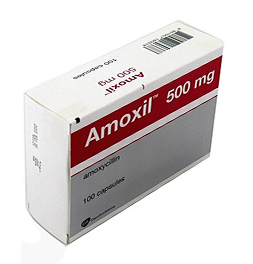 Amoxil is an antibiotic drug that is part of the penicillin group and which contains amoxicillin as an active ingredient. Its mechanism of action is aimed at suppressing pathogenic agents.
Amoxil is an antibiotic drug that is part of the penicillin group and which contains amoxicillin as an active ingredient. Its mechanism of action is aimed at suppressing pathogenic agents.
Escherichia coli, streptococci, mycoplasmas, viruses, and staphylococci are examples of bacteria that are sensitive to the effects of this medication.
This drug eliminates pathogens by acting on their cell walls. Not all bacteria are sensitive to the drug, so, prior to treatment, the patient should be tested to as to clarify the pathogen(s) that are present.
Form of release
Amoxicillin is produced in capsules with a dosage of either 250 mg or 500 mg.
Indications for use
This antibiotic should be taken in the case of infectious diseases of the respiratory system. The drug is effective against the following pathological processes: tracheitis, pneumonia, pharyngitis, laryngitis, bronchitis, and sinusitis.
Amoxil works especially effectively in the treatment of inflammation in the ear (otitis) and acute tonsillitis (angina).
 The drug can be used in the inflammatory processes of the membranes of the spinal cord and brain. The administration of Amoxil often notably improves the condition of a patient who has a severe infectious disease such as sepsis. The remaining indications for the use of the medicinal product include:
The drug can be used in the inflammatory processes of the membranes of the spinal cord and brain. The administration of Amoxil often notably improves the condition of a patient who has a severe infectious disease such as sepsis. The remaining indications for the use of the medicinal product include:
- Infections such as Lyme disease (tick-borne borreliosis), bacterial infections caused by listeria bacteria, and leptospirosis
- Diseases of the genital system as well as those of the urinary tract caused by gram-negative diplococcus; inflammation of the walls of the bladder, the inner layer of the uterus, and the walls of the urethra; and corruption of the tubular system of the kidney
- Problems with the intestines such as lesions of salmonella, shigellosis (dysentery), or typhoid fever
- Skin diseases like infectious erysipelas and impetigo
Side effects
Almost all antibiotics cause some side effects. Amoxicillin can have a devastating impact on the digestive system.
Patients taking this medication have reported diarrhea, impaired microflora, inflammation of the tongue (glossitis), attacks of nausea, damage to the oral mucosa (stomatitis), vomiting, and taste disturbance.
Violations in the nervous system may also occur—albeit very rarely—during the administration of antibiotics.
According to the instructions for use, the appearance of side effects in the form of allergic reactions is possible; examples include hay fever, urticaria, and inflammation of the mucous membrane of the eye (i.e., conjunctivitis).
Cramps, insomnia, dizziness, agitation, headaches, anxiety, and depressive symptoms may also occur.
Contraindications to use
Bactericidal drugs cannot be used during lactation. It is forbidden to use the medicine for the management of allergic diseases such as bronchial asthma or seasonal allergic rhinoconjunctivitis, or in the case of allergies to antibacterial drugs of the penicillin group.
Contraindications to the use of Amoxil include blood cancer (lymphocytic leukemia), liver disease in the form of liver failure, pathology of the intestinal microflora (dysbacteriosis), and viral infections (infectious mononucleosis).
Instructions for use
Patients may take the drug regardless of food intake. The process of digestion does not affect the absorption of the components of the drug; furthermore, the intake of Amoxil does not affect the absorption of the ingredients of the drug.
According to the instructions for use, Amoxil 250 mg can be prescribed for children aged between five years and 10 years old. However, children in this age range are forbidden to take more than this dose.
The dosage for adults and children older than 12 years whose weight exceeds 40 kg is 500 mg three times a day. If necessary, the dose of capsules can be increased to 1,000 mg three times a day. The maximum safe dose is 6 g for adults.
Notably, for specific diseases, the dose may be different, as follows:
- Leptospirosis: up to 750 mg four times
- Typhoid fever: up to 2 g three times
- Acute gonorrhea: 3 g one time
After eliminating the symptoms of a disease, treatment with Amoxil should be carried out for an additional three days as a preventive measure against relapse.
The standard course of treatment with the drug according to the instructions lasts up to 12 days in length.